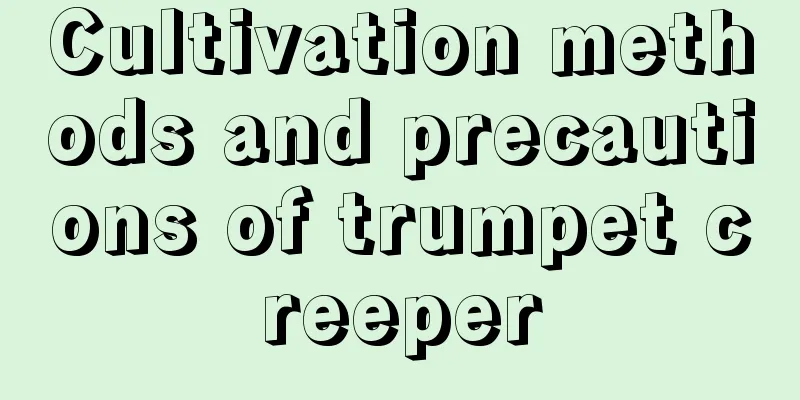Cultivation methods and precautions of trumpet creeper

How to grow trumpet creeperPot soil selectionWhen planting potted trumpet creepers, choose deep, airtight clay pots or wooden barrels. Fill the pot with fertile, loose, well-drained, neutral or slightly acidic soil. Alternatively, you can mix leaf mold with garden soil. Soil dug from the street can also be used after being exposed to the sun and adding some base fertilizer. (The best is fertile pine needle soil) Placement EnvironmentTrumpet creeper likes an environment with plenty of sunlight. In a semi-shady environment, the plant will not grow vigorously and the flowers will be few and light in color. Place the plant in a sunny courtyard, balcony, south- or west-facing balcony if possible, and make sure to ventilate it in time. Do not place the flower pots in north-facing or enclosed balconies. Water and fertilizer requirementsTrumpet creeper likes a humid environment, is slightly drought-resistant, and is afraid of waterlogging. Therefore, water the plant frequently during the growing season to keep the soil in the pot slightly moist but not waterlogged. Trumpet creeper will enter a dormant period from late autumn to the following spring. At this time, the soil in the pot should be kept dry and slightly moist. Trumpet creeper is very fond of fertilizer. In addition to adding sufficient base fertilizer to the soil when potting and repotting, nitrogen-based fertilizer should be applied once every 10 to 15 days after germination to promote the growth of branches and leaves. But starting from May , fertilizers mainly composed of phosphorus and potassium should be applied to promote flower bud differentiation and bud formation. Starting from June , spray 0.2% potassium dihydrogen phosphate solution on the leaves once every 7 to 10 days to promote bright blooming. Apply phosphorus and potassium fertilizers 1 to 2 times after the flowers fade to ensure sufficient nutrients before wintering. Trumpet creeper hibernates in winter, so do not fertilize it. Proper trimmingAfter a short dormancy in winter, the plants will enter a vigorous growth period in early spring, so it is necessary to promptly cut off dead branches, weak branches, overgrown branches, and messy branches in early spring, and shorten the overly long branches to promote the sprouting of new strong branches. Precautions for the cultivation of trumpet creeperPest controlThe water and fertilizer requirements for trumpet creeper mention that trumpet creeper likes a humid environment, but also in a high temperature and high humidity environment. Trumpet creeper is easily harmed by aphids. Therefore, it is required to ventilate frequently during the maintenance process to ensure sufficient humidity, but appropriate cooling is required to avoid insect pests. In addition, once aphids are found, rinse them with clean water or spray them with pesticides in time to avoid serious insect infestation. Setting up the support poleTrumpet creeper is a climbing plant. When it grows to a certain extent, it needs to set up supporting poles and build a frame for it to climb and grow. At home, you can place the trumpet creeper at the bottom of the flower stand and let it climb the edge of the flower stand to grow. It can decorate the flower stand and save the trouble of setting up a bracket. Pruning skillsUsually when buds sprout in early spring each year, for plants over 5 years old, the main trunk is shortened to 30~40 cm, and the roots are pruned at the same time to retain the main root system and replant. After new branches sprout out from the pot, only keep 3 to 5 new branches on the top and cut off the rest. Control the water and fertilizer. After a year of maintenance, you will have a beautiful and young trumpet creeper again. |
<<: Classification of lucky tree species
>>: How to grow magnolia at home
Recommend
How to water Phalaenopsis in winter and how to keep warm
1. How to water Phalaenopsis prefers a relatively...
What are the cultivation methods and precautions of small-leafed green radish
Introduction of small leaf green radish The small...
How to breed Hongyun Dangtou
1. Division propagation After this type of plant ...
How to sow six times more seeds
1. Sowing time We have written before about the t...
What season is suitable for planting lettuce? What month is the best for sowing?
The conditions for growing lettuce are not very h...
Can you grow succulents in peat soil?
Can peat soil be used to grow succulents? Peat so...
How to water the creeping bellflower
The plant's water requirements This plant was...
Is it easy to grow pansies? Potted pansies cultivation methods and precautions
Is it easy to grow pansies? Pansies are not easy ...
How to grow woody crabapple
1. Lighting Woody Begonia is a sun-loving flower,...
How to plant apple seeds
1. Seed collection After eating the apple, take o...
Can Blue Stone Lotus protect against computer radiation?
Can Blue Stone Lotus release computer radiation? ...
Is Clerodendrum thomsoniae poisonous? Can it be grown indoors?
1. Has trace toxicity The Clerodendrum thomsoniae...
How to water camellia in spring
1. Watering time Although it is spring, the tempe...
When is the best month to plant iron stick yam?
When to plant iron stick yam Iron stick yam is us...
How does white clover survive the winter
prune Because white clover is generally not prune...









